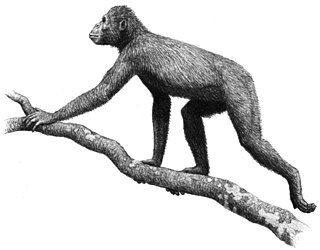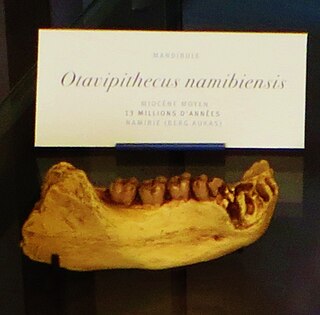
Orrorin tugenensis is a postulated early species of Homininae, estimated at 6.1 to 5.7 million years ago and discovered in 2000. It is not confirmed how Orrorin is related to modern humans. Its discovery was used to argue against the hypothesis that australopithecines are human ancestors, although this remains the most prevalent hypothesis of human evolution as of 2012.

Apes are a clade of Old World simians native to sub-Saharan Africa and Southeast Asia, which together with its sister group Cercopithecidae form the catarrhine clade, cladistically making them monkeys. Apes do not have tails due to a mutation of the TBXT gene. In traditional and non-scientific use, the term "ape" can include tailless primates taxonomically considered Cercopithecidae, and is thus not equivalent to the scientific taxon Hominoidea. There are two extant branches of the superfamily Hominoidea: the gibbons, or lesser apes; and the hominids, or great apes.

Proconsul is an extinct genus of primates that existed from 21 to 17 million years ago during the Miocene epoch. Fossil remains are present in Eastern Africa including Kenya and Uganda. Four species have been classified to date: P. africanus, P. gitongai, P. major and P. meswae. The four species differ mainly in body size. Environmental reconstructions for the Early Miocene Proconsul sites are still tentative and range from forested environments to more open, arid grasslands.

The Hominini form a taxonomic tribe of the subfamily Homininae ("hominines"). Hominini includes the extant genera Homo (humans) and Pan and in standard usage excludes the genus Gorilla (gorillas).

Proconsul africanus was an ape which lived from about 23 to 14 million years ago during the Miocene epoch. It was a fruit eater and its brain was larger than that of a monkey, although probably not as large as that of a modern ape.

Proconsul major, an extinct primate of the genus Proconsul, was possibly the ancestor of Afropithecus and showed hominid characteristics. It occurred during the early Miocene and was roughly, the size of a gorilla. The species previously referred to as Ugandapithecus major is now considered to be a synonym of Proconsul major. Prior to 2000 it was known as Proconsul major and some argue against the renaming.

Afropithecus is a genus of Miocene hominoid with the sole species Afropithecus turkanensis, it was excavated from a small site near Lake Turkana called Kalodirr in northern Kenya in 1986 and named by Richard Leakey and Meave Leakey. The estimated age of Afropithecus is between 16 and 18 million years old, which was determined with radiometric dating techniques and the geological studies conducted by Broschetto and Brown from the University of Utah. In total there are 46 recovered specimens from Kalodirr relating to Afropithecus consisting of cranial, mandible, dentition and post-cranial remains. The type specimen of Afropithecus turkanensis is KNM-WK 16999.

Ekembo nyanzae, originally classed as a species of Proconsul, is a species of fossil primate first discovered by Louis Leakey on Rusinga Island in 1942, which he published in Nature in 1943. It is also known by the name Dryopithecus africanus. A joint publication of Wilfrid Le Gros Clark and Louis Leakey in 1951, "The Miocene Hominoidea of East Africa", first defines Proconsul nyanzae. In 1965 Simons and Pilbeam replaced Proconsul with Dryopithecus, using the same species names.

Rusinga Island, with an elongated shape approximately 10 miles (16 km) from end to end and 3 miles (5 km) at its widest point, lies in the eastern part of Lake Victoria at the mouth of the Winam Gulf. Part of Kenya, it is linked to Mbita Point on the mainland by a causeway.

Martin Pickford was lecturer in the Chair of Paleoanthropology and Prehistory at the Collège de France and honorary affiliate at the Département Histoire de la Terre in the Muséum national d'Histoire. In 2001, Martin Pickford together with Brigitte Senut and their team discovered Orrorin tugenensis, a hominid primate species dated between 5.8 and 6.2 million years ago and a potential ancestor of the genus Australopithecus.

Samburupithecus is an extinct primate that lived in Kenya during the middle to late Miocene. The one species in this genus, Samburupithecus kiptalami, is known only from a maxilla fragment dated to 9.5 million years ago discovered in 1982 and formally described by Ishida & Pickford 1997. The type specimen KNM-SH 8531 was discovered by the Joint Japan-Kenya Expedition at the SH22 fossil site in the Samburu District, a locality where several other researchers found no ape fossils.

The Hominidae, whose members are known as the great apes or hominids, are a taxonomic family of primates that includes eight extant species in four genera: Pongo ; Gorilla ; Pan ; and Homo, of which only modern humans remain.
Kamoyapithecus was a primate that lived in Africa during the late Oligocene period, about 24.2-27.5 million years ago. First found in 1948 as part of a University of California, Berkeley expedition, it was at first thought to be under a form of Proconsul by C.T. Madden in 1980, but after a re-examination by Meave Leakey and associates later, the fossils were moved under a new genus Kamoyapithecus, named after the renowned fossil finder Kamoya Kimeu. The genus is represented by only one species, K. hamiltoni.
Maboko Island is a small island lying in the Winam Gulf of Lake Victoria, in Nyanza Province of western Kenya. It is about 1.8 km long by 1 km wide. It is an important Middle Miocene paleontological site with fossiliferous deposits that were discovered in the 1930s. The age of the deposits is estimated to be 15 to 16 million years, and they are especially important for the abundance of primate fossils they contain.

Rangwapithecus is an extinct genus of ape from the Early Miocene of Kenya. Late Miocene phalanges from Hungary have also been assigned to this genus, but were later reclassified as Dryopithecus.

Nacholapithecus kerioi was an ape that lived 14-15 million years ago during the Middle Miocene. Fossils have been found in the Nachola formation in northern Kenya. The only member of the genus Nacholapithecus, it is thought to be a key genus in early hominid evolution. Similar in body plan to Proconsul, it had a long vertebral column with six lumbar vertebrae, no tail, a narrow torso, large upper limbs with mobile shoulder joints, and long feet.
Simiolus is an extinct genus of dendropithecid primates. It was described by Mary Leakey and Richard Leakey in 1987, and the type species is S. enjiessi, which existed during the Miocene of Kenya. The species epithet is a phonetic pun on the acronym NGS. A new species, S. andrewsi, also from the middle Miocene of Kenya, was described by Terry Harrison in 2010. In November 2018, scientists reported the discovery of the smallest known ape, Simiolus minutus, which weighed approximately eight pounds, and lived about 12.5 million years ago in Kenya in East Africa.

Ekembo is an early ape (hominoid) genus found in 17- to 20-million-year-old sediments from the Miocene epoch. Specimens have been found at sites around the ancient Kisingiri volcano in Kenya on Rusinga Island and Mfangano Island in Lake Victoria. The name Ekembo is Suba for "ape" or "monkey".

Otavipithecus namibiensis is an extinct species of ape from the Miocene of Namibia. The fossils were discovered at the Berg Aukas mines in the foothills of the Otavi mountains, hence the generic name. The species was described in 1992 by Glenn Conroy and colleagues, and was at the time the only non-hominin fossil ape known from southern Africa. The fossils consist of part of the lower jawbone with molars, a partial frontal bone, a heavily damaged ulna, one vertebra and a partial finger bone.

















